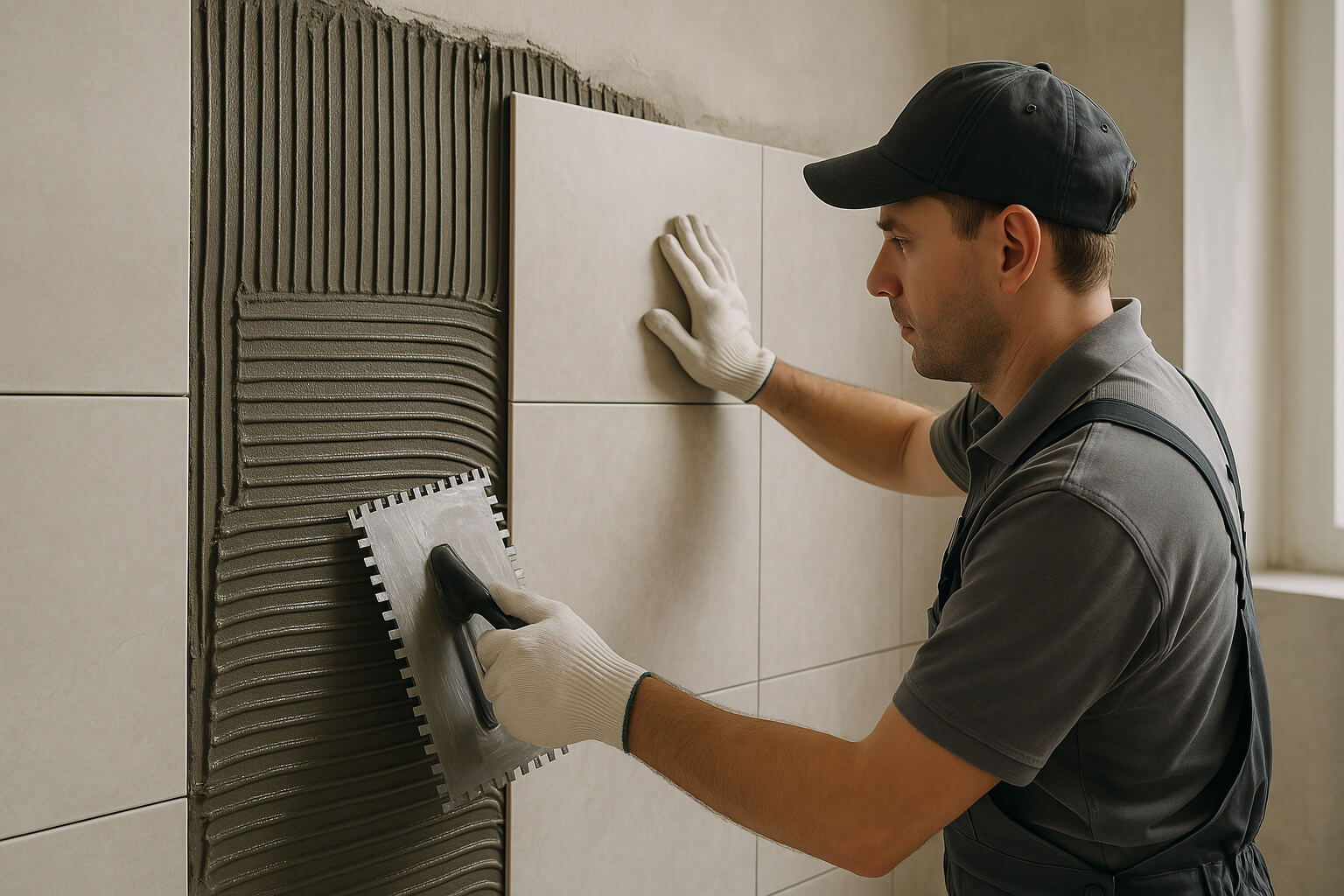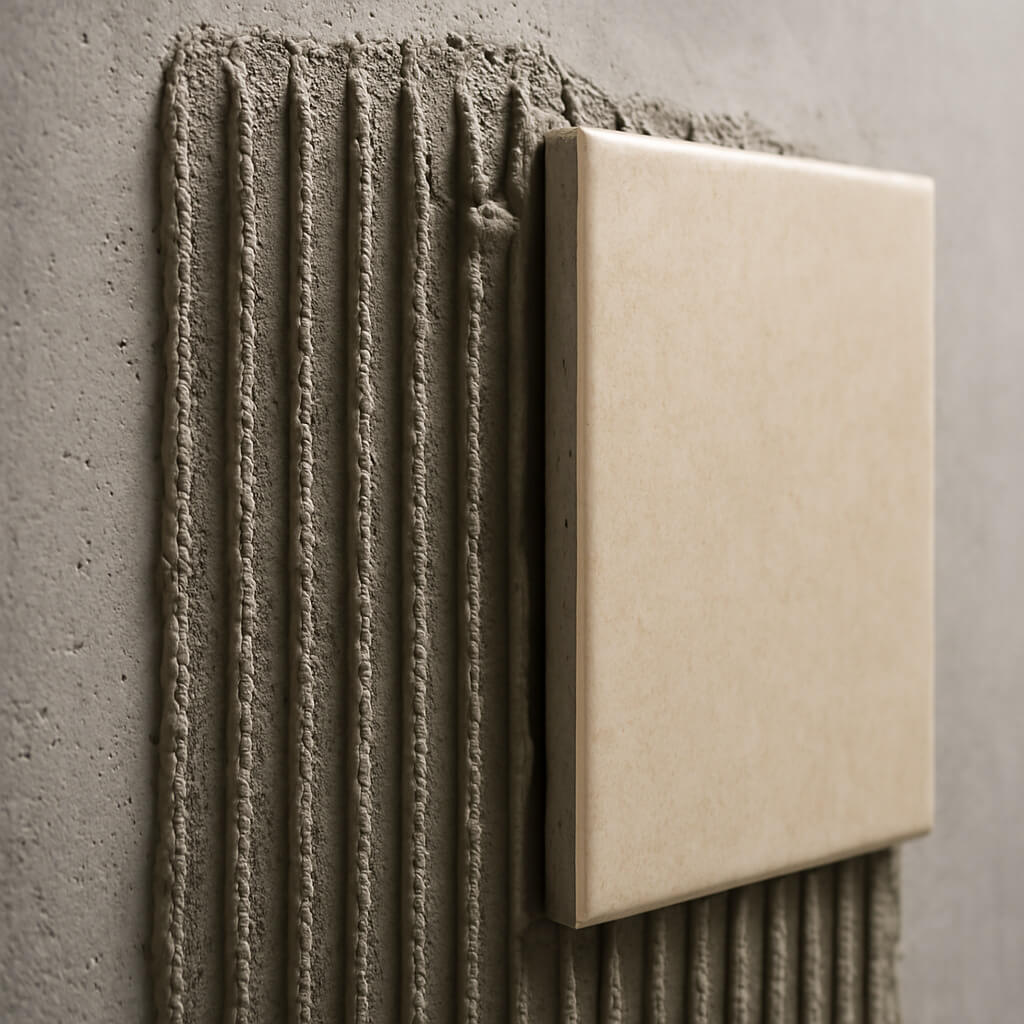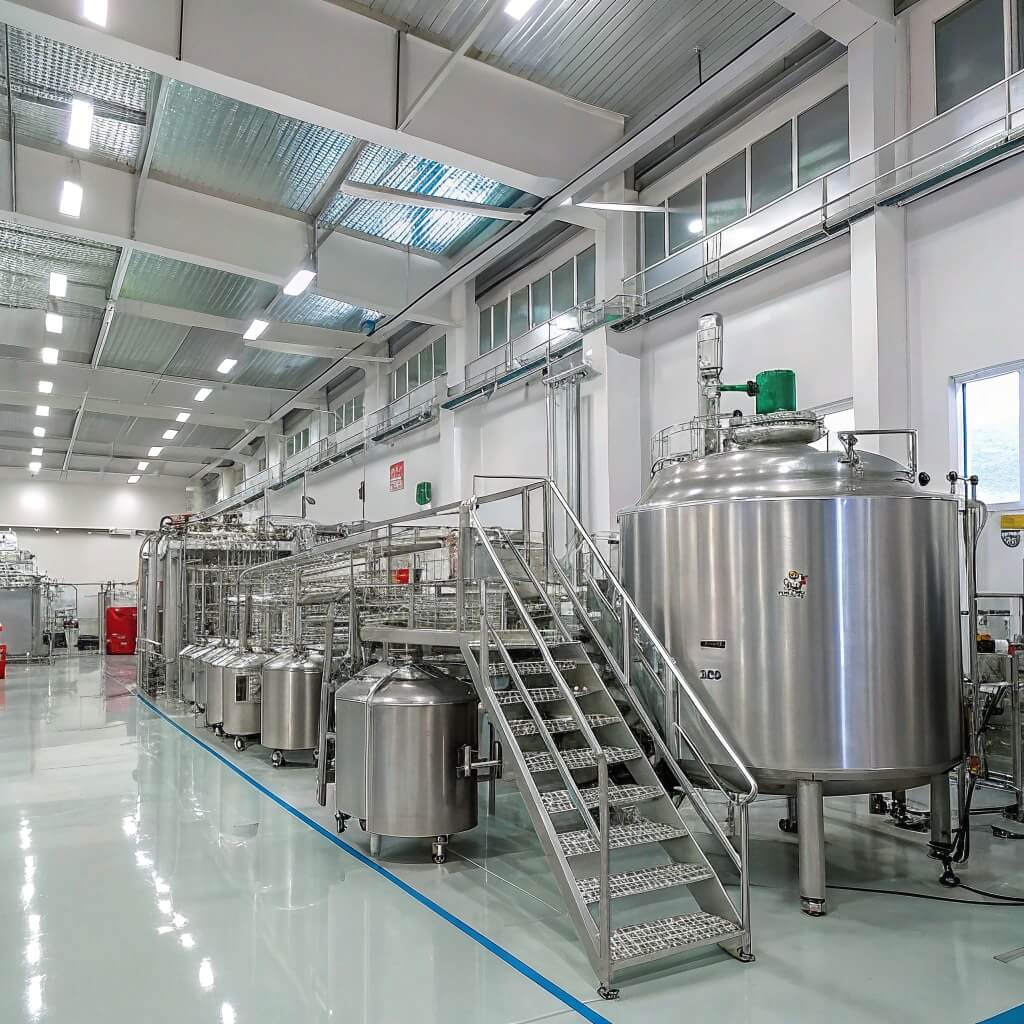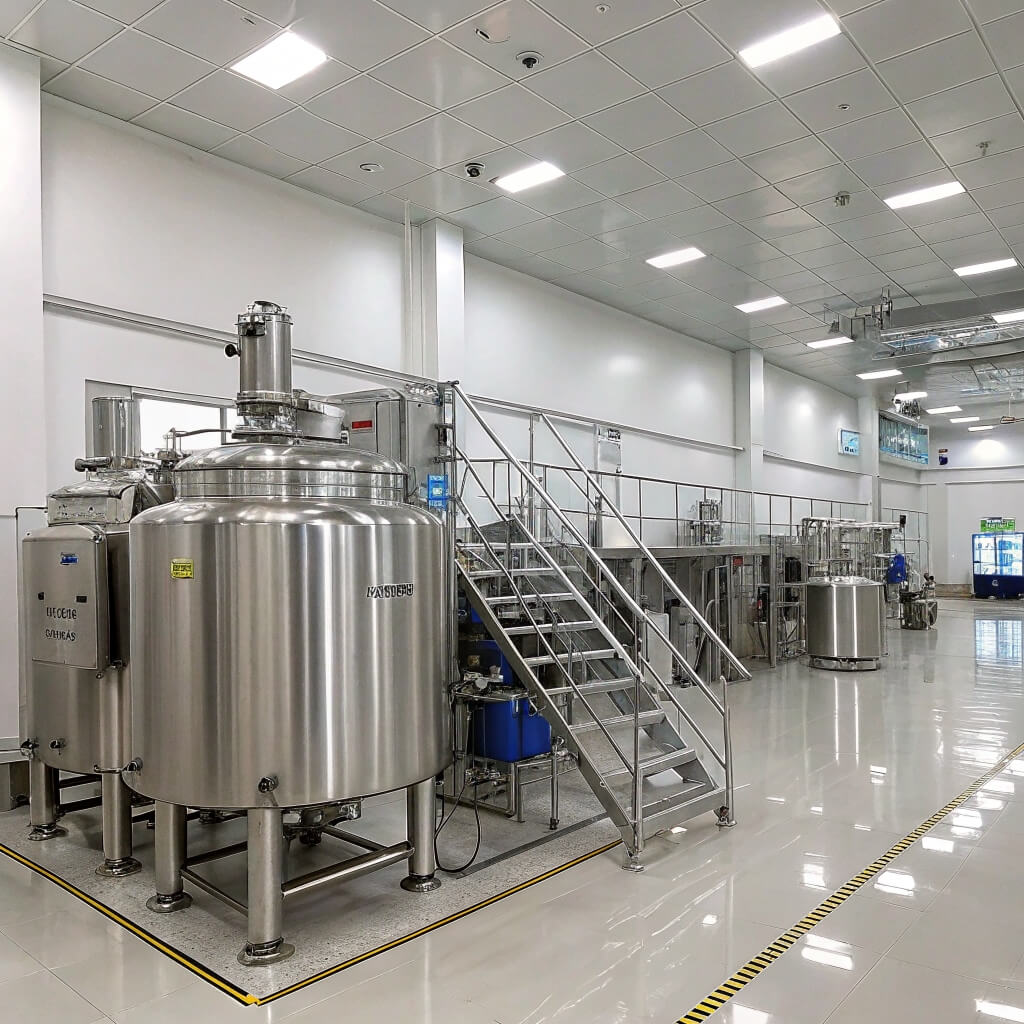Waiting for tile adhesive to set properly can make or break your installation project. Timing issues cause frustration for even seasoned professionals.
Hydroxypropyl Methylcellulose (HPMC) acts as a critical water retention agent that significantly extends the setting time of tile adhesives, allowing proper tile placement adjustments while maintaining optimal consistency for professional-grade installations.

A professional installer adjusting ceramic tiles on a fresh adhesive layer containing HPMC, showing the extended working time benefit for precise alignment.
Many installers focus on adhesive strength but overlook setting time control. Let's examine how HPMC creates the perfect working window for successful tile projects.
What is the connection between HPMC and tile adhesive setting behavior?
Ever applied adhesive only to have it dry before finishing your tile layout? This common problem ruins installations and wastes expensive materials.
HPMC forms a protective gel matrix within tile adhesive that regulates water movement, preventing premature drying while maintaining proper viscosity and establishing a controlled setting mechanism essential for professional installations.
We've manufactured HPMC for tile adhesive applications for over a decade, giving us unique insight into its setting control mechanisms. The relationship between HPMC and adhesive setting behavior stems from its fundamental physical properties. When mixed into adhesive formulations, HPMC molecules interact with water through hydrogen bonding, creating a three-dimensional network throughout the mixture.
This network serves multiple critical functions. First, it significantly reduces water evaporation rates by physically binding water molecules within the adhesive mass. Second, it forms a temporary barrier that slows cement hydration reactions. Third, it maintains consistent rheological properties across varying environmental conditions.
Our laboratory tests consistently show that HPMC viscosity directly correlates with setting time. Higher viscosity HPMC grades can extend working time by 30-45 minutes compared to unmodified formulations, while still allowing for proper curing within acceptable timeframes. This balance between workability and eventual strength development makes HPMC an essential component in modern adesivi per piastrelle, according to industry associations monitoring construction materials.
The physics behind this process involves controlled water management rather than simply "slowing" the entire reaction. We observe that properly formulated HPMC-modified adhesives maintain their original properties even after repeated troweling and adjustments - a key performance indicator for professional-grade materials.
How does HPMC delay the setting time of tile adhesives?
Watched a perfectly good batch of adhesive harden in the bucket while you were still prepping the installation area? Chemical reactions wait for no one unless properly controlled.
HPMC delays setting through three primary mechanisms: it creates a protective colloidal network around cement particles inhibiting rapid hydration, maintains optimal water distribution throughout the adhesive layer, and forms a temporary protective film reducing moisture loss to porous substrates.
The science behind HPMC's setting time modification capabilities comes from its unique molecular structure. Our production processes can carefully control substitution levels and molecular weight distributions to achieve specific setting profiles. When integrated into cement-based adhesives, HPMC molecules strategically position themselves between cement particles and water.
The following mechanisms demonstrate how HPMC effectively delays setting time:
- Hydration control - HPMC temporarily coats cement particles, controlling water access
- Water retention - Hydroxyl groups in the HPMC structure bond with water molecules
- Rheology modification - Changes in flow properties reduce water migration
- Film formation - Creates microscopic barriers against rapid evaporation
- Substrate interaction - Reduces excessive water absorption into porous surfaces
Our manufacturing experience shows that different HPMC grades produce predictable setting time modifications. For example, our medium-viscosity HPMC (60,000 mPa·s) typically extends working time by 35-45 minutes in standard cement formulations. Higher molecular weight variants can extend this even further when environmental conditions demand it.
Electron microscopy studies conducted in our laboratories reveal that HPMC creates a distinct microstructure within the adhesive matrix. This structure not only delays initial set but promotes more complete hydration over time, ultimately enhancing long-term bond strength as researchers from materials science journals have confirmed.
What benefits does extended setting time bring to tile installers?
Rushing through tile installation leads to misalignments, poor adhesion, and eventual failures. The pressure to work quickly compromises quality and professional reputation.
Extended setting time delivers four critical advantages: adequate adjustment time for precise tile alignment, reduced waste from premature drying, improved coverage by maintaining optimal consistency, and better bond strength through more complete cement hydration.
From our extensive work with professional tiling contractors across Europe and North America, we've documented numerous tangible benefits of properly controlled setting times. Their feedback has directly influenced our HPMC formulation development, helping us create products tailored to real-world installation challenges.
Extended setting time transforms the installation process by providing a substantial working window. This adjustment period proves particularly valuable for complex pattern layouts, large-format tiles, and vertical applications where gravity compounds alignment difficulties. Professional installers working with our HPMC-modified adhesives report 30-40% fewer alignment issues compared to rapid-setting alternatives.
The financial implications extend beyond the immediate installation quality. Material waste reduction represents a significant cost advantage. Our field studies demonstrate that contractors using properly formulated HPMC adhesives experience approximately 22% less waste from prematurely dried product. For large commercial projects, this translates to substantial savings over time.
The technical benefits continue long after installation. When cement has sufficient hydration time under controlled moisture conditions, microscopic crystal structures develop more completely. In practical terms, this means better adhesive penetration into both the substrate and tile backing, creating stronger mechanical bonds. Testing shows that optimized setting times correlate with up to 15% improvement in final bond strength measurements.
Project scheduling also benefits substantially from predictable working times. Installation teams can better coordinate their activities, particularly with large crews working across expansive areas. The reliability factor reduces stress and promotes methodical, high-quality workmanship – an aspect repeatedly emphasized by our professional customers.
How does the dosage of HPMC influence adhesive performance?
Adding too little or too much HPMC creates unpredictable results. Finding the proper balance challenges many manufacturers and leads to inconsistent product behavior.
The dosage relationship follows a non-linear pattern where concentrations between 0.2-0.5% significantly extend setting time while improving sag resistance, but higher levels above 0.7% can excessively delay curing and potentially compromise final adhesive strength.
| Dosaggio HPMC | Setting Time Impact | Resistenza al cedimento | Overall Adhesive Performance | Recommended Applications |
|---|---|---|---|---|
| 0.1-0.2% | Minimal extension (10-15 min) | Low improvement | Suitable for basic applications | Small format tiles, non-critical areas |
| 0.3-0.5% | Moderate extension (30-45 min) | Excellent improvement | Optimal balance for most uses | Large format tiles, walls, complex patterns |
| 0.6-0.7% | Significant extension (60+ min) | Molto alto | Special applications only | Extreme climates, very large tiles |
| >0.8% | Excessive delay (90+ min) | May become too stiff | Potential strength reduction | Not generally recommended |
Our manufacturing experience has given us deep insights into dosage optimization across various adhesive formulations. The relationship between HPMC concentration and setting behavior follows predictable patterns, allowing formulators to target specific performance characteristics. We carefully control production parameters to ensure consistent viscosity profiles, which directly impacts how accurately manufacturers can predict setting times.
The molecular mechanisms behind dosage effects relate to both physical and chemical interactions within the adhesive matrix. At lower concentrations (0.1-0.2%), HPMC primarily acts as a water retention agent with minimal impact on cement hydration kinetics. As dosage increases to the optimal range (0.3-0.5%), the molecular network becomes sufficiently dense to substantially modify rheology while creating effective barriers to water movement.
When manufacturers exceed recommended dosages, particularly above 0.7%, several potential issues emerge. Excessive water retention can delay necessary hydration reactions too long, potentially compromising final strength development. Additionally, high HPMC concentrations affect workability differently, sometimes creating adhesives that remain initially workable but suddenly stiffen – a phenomenon our laboratory has documented extensively.
We've found that temperature sensitivity also correlates with HPMC dosage. Higher concentrations amplify the effects of environmental conditions, making adhesive behavior less predictable across varying jobsite environments. This relationship underscores the importance of proper dosage calibration according to materials science researchers studying construction chemistry.
What external factors impact how HPMC behaves in tile adhesives?
Environmental variables on jobsites vary dramatically. Temperature swings, humidity fluctuations, and substrate conditions create unpredictable challenges for installers.
Temperature, humidity, substrate porosity, and water quality substantially affect HPMC performance, with higher temperatures accelerating setting despite HPMC presence, while increased humidity and non-porous substrates extend working time beyond standard expectations.
Through our production operations in variable climate regions and extensive field testing programs, we've documented precisely how external factors interact with HPMC-modified adhesives. These insights allow us to provide application-specific recommendations based on anticipated installation conditions.
Temperature stands as the most significant external influence on setting behavior. Our technical data shows that for every 10°C increase in ambient temperature, setting time typically decreases by 15-20% even with optimal HPMC content. This relationship becomes particularly critical in warm weather installations where accelerated drying can compromise proper tile placement.
Substrate porosity creates another critical variable affecting HPMC performance. Highly absorbent surfaces like unprimed gypsum board or dry concrete can withdraw moisture from the adhesive layer, counteracting HPMC's water retention capabilities. Our field measurements indicate that extremely porous substrates can reduce effective working time by up to 40% compared to standard conditions, regardless of HPMC content.
Conversely, non-absorbent substrates like existing tile or certain waterproofing membranes prevent moisture migration entirely. In these scenarios, HPMC's effect becomes more pronounced, sometimes extending working time beyond what's desirable for project timelines. Professional installers must adjust their application approach accordingly.
Relative humidity influences the moisture equilibrium between the adhesive and surrounding air. High humidity conditions (above 70% RH) typically extend working time by reducing evaporation rates. Our testing shows approximately 25% longer adjustment windows in high humidity environments compared to standard conditions (40-60% RH).
Water quality variations, particularly mineral content and pH values, can interact with HPMC's hydroxyl groups and affect gel formation. Hard water with high calcium content sometimes reduces HPMC effectiveness slightly, though modern HPMC formulations have become increasingly tolerant of these variations through manufacturing improvements our technical team has implemented.
What key formulation strategies improve setting control in tile adhesives?
Generic approaches to adhesive formulation produce disappointing results. Without strategic ingredient selection and precise proportioning, setting time remains unpredictable.
Effective formulation strategies include utilizing specialized HPMC grades with targeted substitution patterns, balancing complementary additives like starch ethers or synthetic polymers, optimizing cement types and particle sizes, and incorporating setting accelerators to counterbalance extended open time.
In our manufacturing facility, we produce multiple HPMC grades specifically engineered for construction applications. The most critical formulation factor involves selecting the appropriate molecular weight and substitution pattern. Our highest-performing tile adhesive grades feature carefully balanced hydroxypropyl to methoxy ratios that optimize water retention without excessive stickiness or delayed final curing.
Successful formulations rarely rely on HPMC alone. The synergistic relationship between HPMC and other additives creates more stable performance across varying conditions. Our technical team recommends these proven approaches:
- Combine HPMC with redispersible polymer powders (RPP) to enhance flexibility while maintaining setting control
- Balance cement/aggregate ratios to complement HPMC's water retention properties
- Select appropriate cement types – Portland Type I provides more predictable setting with HPMC than rapid-hardening varieties
- Incorporate small amounts of setting accelerators to offset excessive delays when necessary
- Consider surfactant additions to improve HPMC dissolution and distribution throughout the mixture
The cement component itself significantly influences how HPMC functions within the formulation. Finer cement particles with higher surface areas interact more extensively with HPMC molecules, sometimes requiring dosage adjustments. Through our R&D program, we've determined that medium-ground cements typically provide the most predictable performance with standard HPMC grades.
Advanced formulation approaches sometimes include thermal stability enhancers that reduce temperature sensitivity of the HPMC network, according to research from construction chemistry associations. These specialized additives help maintain consistent setting profiles across broader temperature ranges, a significant advantage for products sold in regions with variable climates.
The final consideration involves balancing extended working time with reasonable final setting requirements. While prolonged adjustment periods benefit installers, excessive delays before trafficking or grouting create project timeline issues. Modern formulations achieve this balance through carefully sequenced setting mechanisms – HPMC controls initial set while complementary additives ensure timely final curing.
Domande frequenti
What is the role of HPMC in tile adhesive?
HPMC serves as a critical multifunctional additive in tile adhesives, primarily retaining water to extend working time while simultaneously improving adhesive consistency and sag resistance. Its hydroxyl groups form hydrogen bonds with water molecules, creating a protective gel network that slows evaporation and controls cement hydration rates. HPMC also enhances adhesive spreadability, making application more efficient while providing the necessary open time for precise tile placement and adjustment.
Why has my tile adhesive not set?
Several factors might prevent proper setting: excessive HPMC concentration (above 0.7%), extremely low temperatures (below 10°C/50°F), high humidity environments, or non-absorbent substrates that prevent moisture migration. Check if your adhesive contains appropriate cement content, as some economy formulations may have insufficient reactive materials. Most commonly, over-thinning the adhesive with too much water disrupts the chemical balance needed for proper setting. Try applying a thinner layer or using a dehumidifier in extremely damp conditions.
How can I speed up the drying time of tile adhesive?
To accelerate setting time while maintaining adhesive quality, increase ventilation in the work area, maintain moderate warmth (21-25°C/70-77°F), and use fans to circulate air without directly blowing on the adhesive surface. Select a lower-viscosity HPMC-modified adhesive specifically formulated for faster setting. Avoid excessive water during mixing, as this significantly extends drying time. For critical timeline projects, consider specialized rapid-set formulations containing setting accelerators like calcium formate that balance HPMC's water retention while promoting faster strength development.
In che modo la temperatura influisce sull'HPMC?
Temperature significantly influences HPMC behavior in tile adhesives through multiple mechanisms. At higher temperatures (above 30°C/86°F), HPMC's water retention capacity decreases as thermal energy weakens hydrogen bonding, resulting in faster setting despite HPMC presence. Conversely, colder conditions (below 15°C/59°F) strengthen hydrogen bonds while slowing cement hydration reactions, extending setting time substantially. Temperature also affects HPMC dissolution during mixing—cold water slows gel formation while warm water accelerates it. Modern HPMC grades maintain better thermal stability, but temperature remains the most influential external factor affecting their performance in adhesive applications.
Conclusione
HPMC transforms ordinary tile adhesives into professional-grade materials by providing the essential setting time control that ensures successful installations. Through its unique water retention mechanisms, HPMC creates the critical working window needed for proper tile placement, alignment, and adjustment.
We've seen firsthand how proper HPMC selection dramatically improves adhesive performance across diverse installation challenges. The right viscosity grade and dosage deliver predictable setting behavior while enhancing adhesive properties from application through final curing. This balance of extended working time without excessive delays makes HPMC indispensable in quality tile adhesive formulations.
For tile adhesive manufacturers seeking consistent setting performance and exceptional water retention, contact our technical team at Morton for specialized HPMC grades engineered specifically for construction applications. Our production expertise ensures you'll receive precisely the performance characteristics your formulations require.




